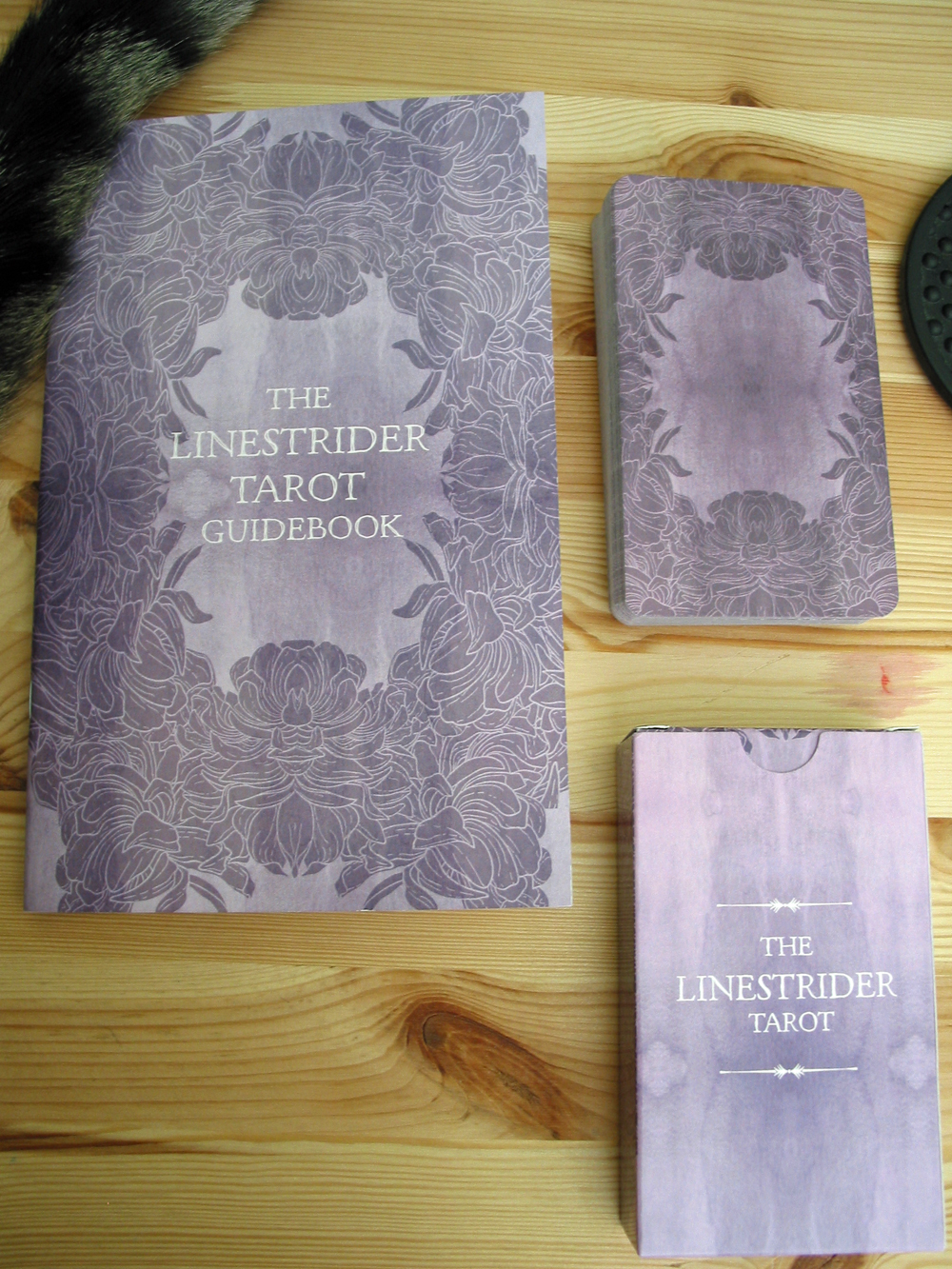
The Linestrider Tarot by Siolo Thomson was funded through Indiegogo in the spring of 2015. I jumped on the funding campaign’s bandwagon at the last minute once I saw pictures of these beautiful cards. They were produced in a very limited edition, but fortunately they will be published Llewellyn in the spring or summer of 2016. Since this is a rare deck that’s soon to become widely available, I thought it would be helpful to people who might be interested in the Llewellyn release of this deck.
The bottom line is that I love this deck. I connected to it instantly and started to read with it right away. This is a different experience than the one I had with the Wild Unknown, for example, which although I was drawn to the images online had a bit of a learning curve once I actually got the deck in my hands and started reading with it. Thomson is an artist and this deck is just a small part of her amazing portfolio. (If you are not following her on Instagram you should.) Generally, I’m extremely picky about what my decks look like and this is a dream as far as artist’s decks go. It’s a borderless deck and it’s very light–not thematically, but there’s a lot of white space which allows Thomson’s delicate and colorful images to shine. A few cards have images that go all the way to the edge, but generally speaking each image is surrounded white space.
So, to begin with the basics, the Linestrider Tarot has pretty standard card stock, like what you’d find on most tarot decks from US Games Systems, for example. It’s the second thinnest of all my decks, being thinner than the Dreaming Way and thicker than the Shadowscapes by just a smidge. The cards are pretty flexible and bend easily, so I have been careful with them. I know a lot of independent decks have been going for the really thick high quality cards lately, so just know that’s not what you’ll be getting here.
 The deck comes with a booklet which offers a couple of spreads but is mostly taken up with Thomson’s descriptions of the cards. All my quibbles with the deck/book set have to do with the format of the guidebook, although the contents are great. The cover of the guidebook itself is beautiful, so I was disappointed to open it up and find that it was laid out in the plainest of the plain ways. I read books for a living, so I appreciate good book design and definitely notice when it’s not present. The font on all of the card explanations is also super tiny. If you are over 45, prepare to get out your reading glasses and a magnifying glass. My guess is that Thomson took a Word document formatted in 8 1/2″x11″ and just shrank it down to the 5 1/2″x8 1/2″ for the book.
The deck comes with a booklet which offers a couple of spreads but is mostly taken up with Thomson’s descriptions of the cards. All my quibbles with the deck/book set have to do with the format of the guidebook, although the contents are great. The cover of the guidebook itself is beautiful, so I was disappointed to open it up and find that it was laid out in the plainest of the plain ways. I read books for a living, so I appreciate good book design and definitely notice when it’s not present. The font on all of the card explanations is also super tiny. If you are over 45, prepare to get out your reading glasses and a magnifying glass. My guess is that Thomson took a Word document formatted in 8 1/2″x11″ and just shrank it down to the 5 1/2″x8 1/2″ for the book.
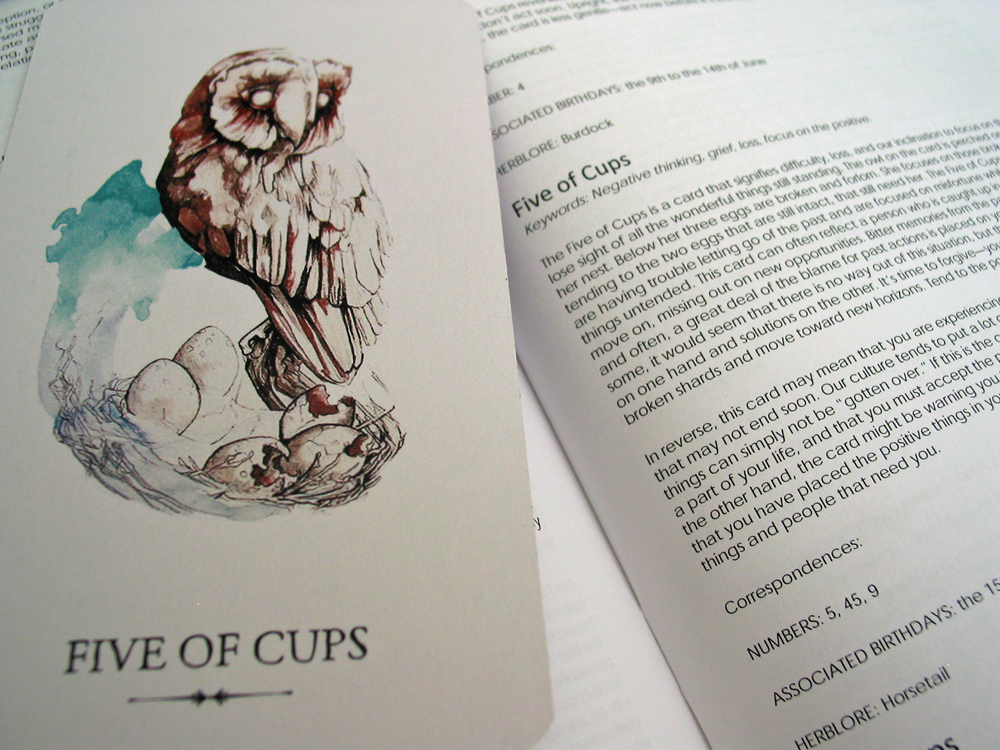
Because the deck is, well, a standard sized deck and the folded-and-stapled guidebook is so much bigger, the guidebooks were vulnerable to being bent during shipping and mine was slightly damaged. I’m not a huge stickler for stuff like that in general–I will usually buy a book in any condition so long as it’s readable–but since this is a collector’s item I was a little disappointed. The deck and box, though, arrived without any damage. Inside the guidebook there are some proofing errors and inconsistencies, but for me those go to show how much work it actually takes to produce a document like this. As someone who writes a lot but with only myself and friends for proofreaders, I’m always amazed at how many errors can slip by. Producing an error-free book is the work of an entire publishing team. We’re used to error-free books with tarot decks, but that’s because it’s a group effort to produce them.
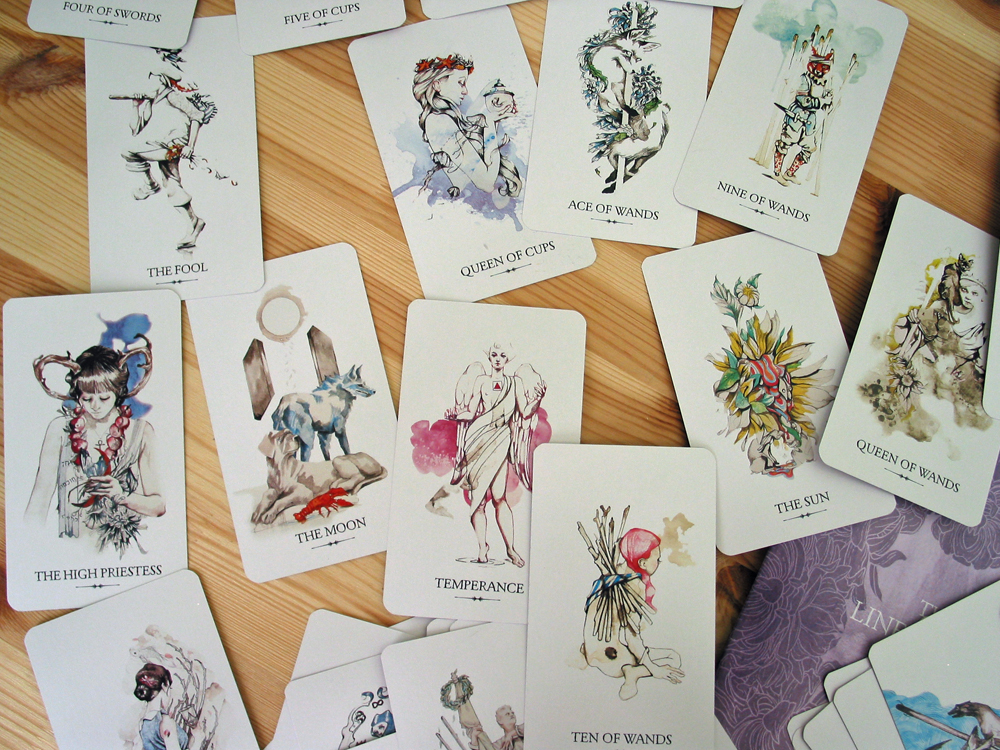
OK, so these are the quibbles. And that’s it. I truly love everything else about this deck. I have not counted, but it seems like the deck is split about 55/45 in terms of human and animal figures. There’s a whole menagerie in this deck–foxes, bears, cats, dogs, birds, fish, lions and tigers, hares and rabbits, deer, goats, and even unusual animals like monkeys, lemurs, and sloths! Only a very few cards lack any animal imagery at all, and those are the ones that feel the most bleak. Thomson also makes heavy use of vegetation and floral imagery.
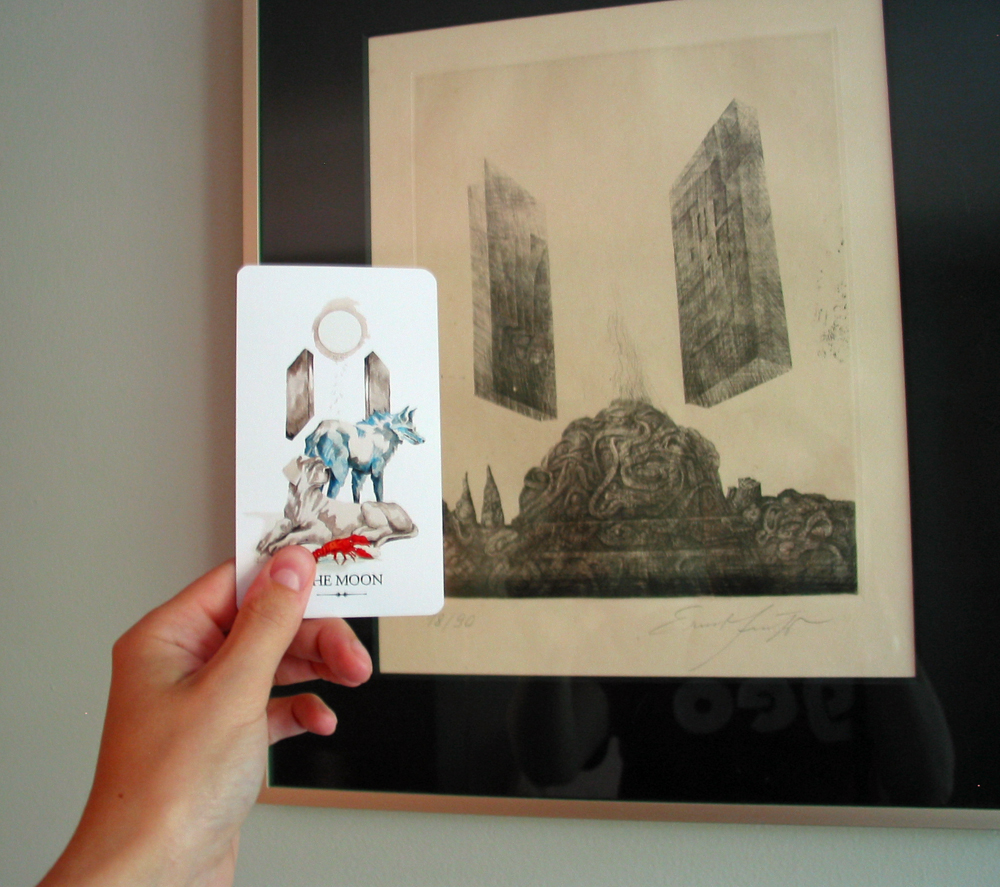
The Linestrider Tarot, although based on the Rider-Waite system, is not an RWS clone by any means. Some of the cards are clone-y, but in most of them Thomson has taken the original card and expressed its meaning in a different but recognizable way. But if you are familiar with the RWS cards, you will have very little trouble reading these. In places where Thomson departs significantly from the RWS deck, she explains why she has done so in the guidebook. For instance, the Hanged Man is a blue tiger hanging upside down on one foot. She explains that she drew him as a tiger because the Hanged Man is not a passive figure, even if he is in a state of suspension. He can spring into action when the time is right. The tiger is blue because blue is “the color of suspended breath, of waiting, of nature in her winter stillness.” She also adds art notes, explaining if she used a particular image or piece of art as a model. (The exception to this is the Moon card, which I wouldn’t have thought twice about, except that it happens to strongly resemble an Ernst Fuchs print that is hanging in my living room! I’m itching to email her and ask about it.)
Overall, I enjoy the contents of the guidebook very much. Thomson’s descriptions of the cards are well thought out. She gives keywords, upright and reversed meanings (always a plus for me), as well as numerological, astrological, birthday, animal, and herbal correspondences for each card. Her descriptions are usually a couple of good paragraphs long, not just keywords or skimpy sentences. And while her accounts of the cards don’t stray that much from the widely accepted meanings, they have an originality to them that shows the depth of thought that she put into them. For the Llewellyn edition, the guidebook will be expanded, which I am very happy about!
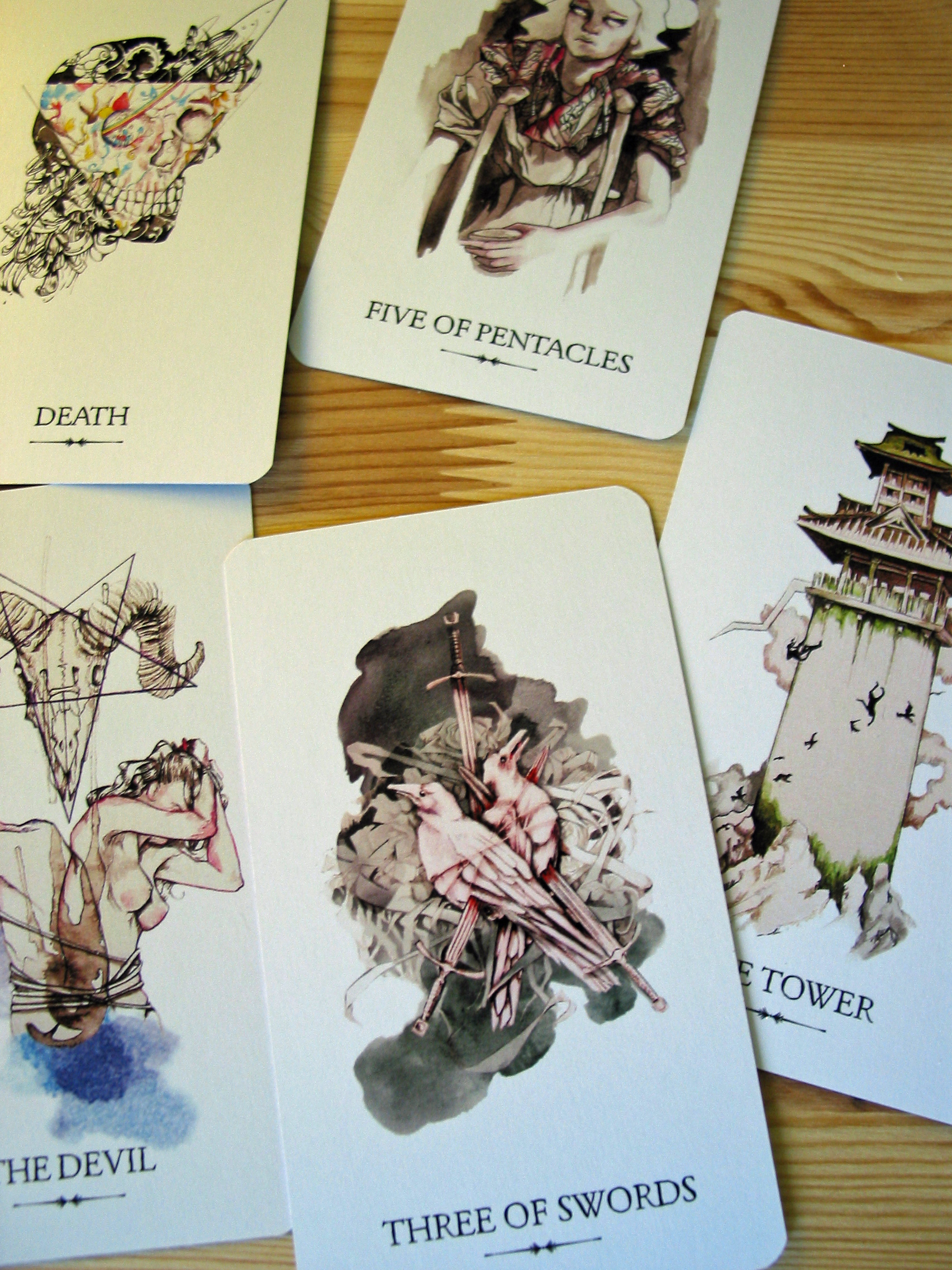
Thomson says herself that the Linestrider Tarot is a gentle deck, but it’s by no means a fluffy deck and it does not sugarcoat the darker moments in the tarot cycle such as the Devil, the Tower, the 3 of Swords, and the 10 of Swords. So it’s not gentle in the sense that it ignores the dark side of life. On the other hand, this deck is not going out of its way to be morbid or dark and even the disturbing images are held by the white space in such a way that they aren’t overwhelming. Rather than gentle, the word I would use is clear–even if you ask a question about a difficult issue, or get an answer that is hard to hear, the images speak with a clarity that is neither harsh nor overbearing.
So what will be the differences between this edition and the Llewellyn edition? I suspect that the packaging will change, although whether the card backs will be the same remains to be seen. I know that some of the cards will be changed as well, but don’t have a whole lot of details on that. Llewellyn editions usually come with perfect bound books, so I’m hoping that there will be an increase of quality on that front. And once it does get published, I hope an app will be made from the deck as well! Overall, this first edition is a proper collector’s item given that it is very limited (my deck is #268 out of 300) and will have major variations from the Llewellyn edition. If you aren’t a collector but just want to read with this deck, it will be worth sitting tight for the LLewellyn edition. If you are a collector, I’m sure there will be a market for this first edition but it’s hard to say what that will look like.
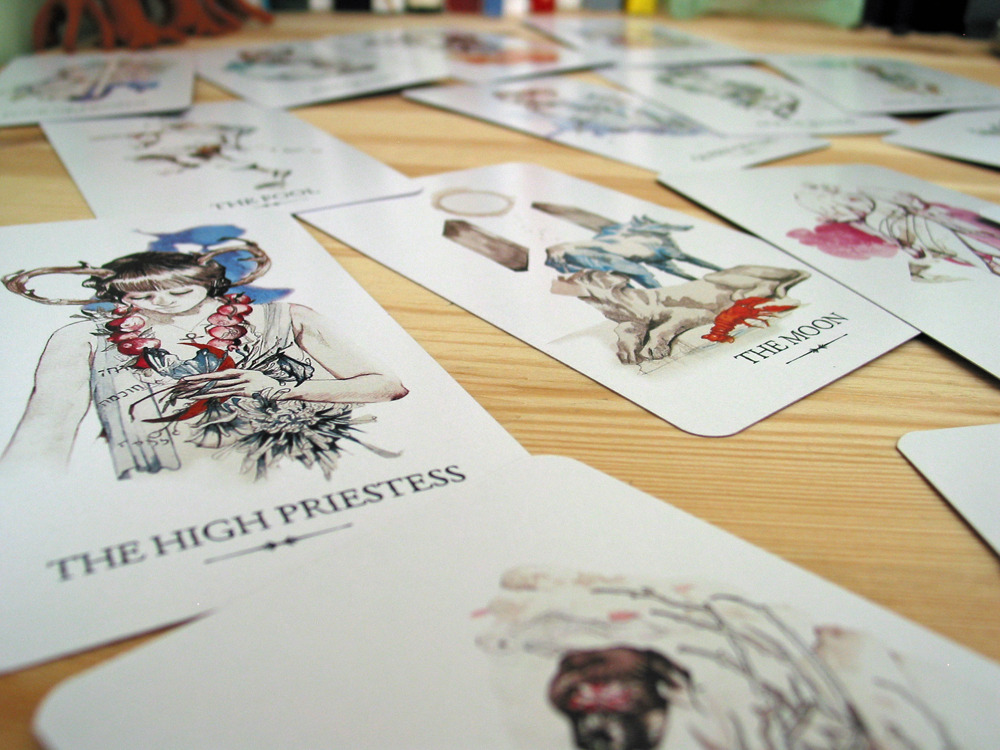
Leave a Reply